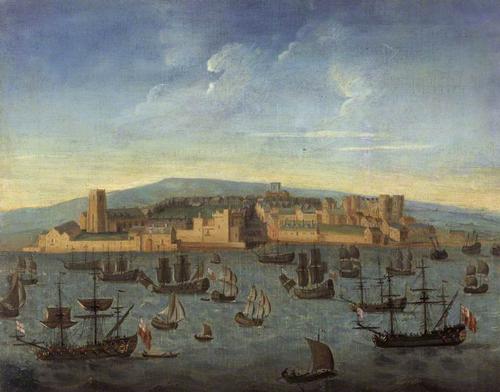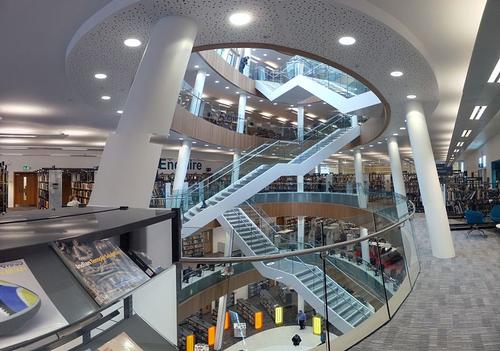ENGLAND
Liverpool

Liverpool
Liverpool
Liverpool is a city on the east bank of the River Mersey in England. Liverpool was founded in 1207 and granted city status in 1880. It is the center of the Merseyside metropolitan area.
The city expanded extensively due to the important role of the port. Trade from the West Indies, Ireland and the European countries took place through this port and the slave trade gave an extra boost to economic growth in the 18th century. Several areas of the city center are protected by UNESCO as part of the World Heritage. Liverpool attracts a large number of tourists, it is the 6th city in terms of visitor numbers in the UK.
 LiverpoolPhoto: LivingOS CC 2.0 Generic no changes made
LiverpoolPhoto: LivingOS CC 2.0 Generic no changes made
According to the 2001 census, Lverpool has a population of 1,381,200 inhabitants. The city itself had a population of 435,500 inhabitants according to the same census. When it comes to Liverpool, most people think of two things: the football club of the same name and the city of the world-famous pop group The Beatles.
Location
The coordinates of Liverpool are: 53° 24' 31' N 2° 58' 48' W
The city is conveniently located on Liverpool Bay in the Irish Sea, 283 km northwest of London. Liverpool is built on sandstone hills, which rise up to 70 meters above sea level. These hills form the southern boundary of the West Lancashire coastal plain. The metropolitan area covers 111.84 km².
Weather
The climate of Liverpool is a moderate maritime climate, comparable to the climate of the British Isles as a whole, with relatively cool summers and mild winters. Due to its location on the coast, the temperature average varies little. The absolute minimum temperature was -12.8 °C in January 1881. The absolute maximum temperature was 34.5 °C in August 1990.
History
 Depiction of Liverpool from 1680Photo: Public Domain
Depiction of Liverpool from 1680Photo: Public Domain
The city was founded in 1207 as a small town and by the mid-16th century, Liverpool had a population of around 500 people. The population grew considerably due to the development of trade in the 17th century. When Liverpool accounted for most of the trade with the West Indies, Ireland and Europe, the city really started to grow. The first commercial dock was built in Liverpool in 1715.
 Albert Dock LiverpoolPhoto: Public Domain
Albert Dock LiverpoolPhoto: Public Domain
The city flourished because of the significant profits from the slave trade. At the beginning of the 19th century, 40% of world trade went through Liverpool. At that time, many buildings against which you could measure the wealth of the residents were realized. The Albert Dock was built in 1846. It was not long before other wet and dry docks were put into service. Pier Head is one of the largest floating wharfs in the world. Liverpool was granted city status in the year 1880.
During World War II, the city was exposed to a series of air strikes that destroyed thousands of homes. In the 1960s, Liverpool was at the center of the world thanks to the Beatles and the new "Merseybeat sound". In 1974, Liverpool became the center city within the Merseyside metropolitan area.
Sights
 Victorian LiverpoolPhoto: Chowells CC 3.0 Unported no changes made
Victorian LiverpoolPhoto: Chowells CC 3.0 Unported no changes made
Liverpool is a particularly attractive city with a wide variety of architectural styles, ranging from 16th century Tudor buildings to modern contemporary architecture. The most notable buildings in the city date from the late 18th century, from the period of the city's greatest growth and prosperity. Liverpool has over 2,500 beautiful buildings. The city has numerous sculptures, more than any other city in the UK except London. There is a range of beautiful Georgian houses. Liverpool has been voted the most beautiful Victorian English city due to its rich architectural heritage. In 2004, various parts of the city were declared a UNESCO World Heritage Site.
 Liverpool Town HallPhoto: Rept0n1x CC 3.0 Unported no changes made
Liverpool Town HallPhoto: Rept0n1x CC 3.0 Unported no changes made
The neighborhood around Castle Street, Dale Street and Old Hall Street, which developed over more than three centuries, has its origins in the Middle Ages. This district is considered to be one of the most important architectural locations in the city. The oldest building in the area is Liverpool City Hall, which sits at the top of Castle Street and dates back to 1754. The building is one of the most extravagantly decorated public buildings in Britain. The city's cultural district is in the area around William Brown Street. The area has numerous cultural attractions such as: libraries, galleries, reading rooms and the Liverpool World Museum.
 Liverpool Central LibraryPhoto: John Bradley CC 3.0 Unported no changes made
Liverpool Central LibraryPhoto: John Bradley CC 3.0 Unported no changes made
The Central Library is located in the center of the city, which includes a huge number of books and important historical documents about Merseyside. You also have access to the internet and tourist information.
 Liverpool Walker Art GalleryPhoto: Rept0n1x CC 3.0 Unported no changes made
Liverpool Walker Art GalleryPhoto: Rept0n1x CC 3.0 Unported no changes made
The Walker Art Gallery is located on William Brown Street, close to the Wellington Column and the Empire Theater in the heart of downtown. The museum was established in the late 19th century. It houses an important collection of works of art, including many paintings. Many were painted by world-renowned artists such as Monet and Rembrandt. Sculptures and ceramics are also exhibited.
The World Museum is one of the most important museums in Merseyside and was founded in the mid-19th century. This huge complex is divided into several sections, including an impressive natural history section with many captivating exhibits. This museum is the largest of its kind in the entire city and is well worth a visit.
 Tate LiverpoolPhoto: Public Domain
Tate LiverpoolPhoto: Public Domain
Overlooking the waterfront, Tate Liverpool exhibits works from the national collection of British art from the 16th century. On average, around 600,000 people visit the Liverpool Tate Gallery every year and a recent renovation has made the hall much more spacious now. Located in the trendy area of the Albert Dok, the museum has a large collection of modern British art.
Tips
 Liverpool Magical Mystery TourPhoto: Calflier001 CC 2.0 Generic no changes made
Liverpool Magical Mystery TourPhoto: Calflier001 CC 2.0 Generic no changes made
The big tourist attraction is taking a Beatles tour of Liverpool. Many companies offer such a tour, from two hours to a full day. Visit the Beatles' Liverpool and see Penny Lane, Strawberry Fields, The Cavern, The Casbah and all the schools and homes the Beatles once lived in. Often you can also ask for a personal touch for your own "Magical Mystery Tour".
 Liverpool Speke HallPhoto: Daviessimo CC 3.0 Unported no changes made
Liverpool Speke HallPhoto: Daviessimo CC 3.0 Unported no changes made
A special attraction for tourists is Speke Hall, a mansion from the Tudor period that is located in the south of the city. It is one of Liverpool's oldest houses and was built in 1598. The building is one of the few surviving Tudor wooden houses. The Anglican Cathedral is the largest cathedral in Britain and the fifth largest in the world. The cathedral is built in Gothic style and is considered one of the largest buildings of the 20th century.
 Liverpool FC MuseumPhoto: Rept0n1x CC 3.0 Unported no changes made
Liverpool FC MuseumPhoto: Rept0n1x CC 3.0 Unported no changes made
The Liverpool Football Club Museum, in the Walton area, is full of interesting exhibitions about the city, the famous football club and the Anfield stadium itself. With many historical items, there is also a lot of information related to some of the club's most famous players, such as football legends Emlyn Hughes, Ian Rush, Michael Owen, Roger Hunt and Steven Gerrard.
Useful links Liverpool
BBC Country ProfilesWorld Fact Book Explore all Countries
How to call
Last updated December 2025
Copyright: Team - The World of Info